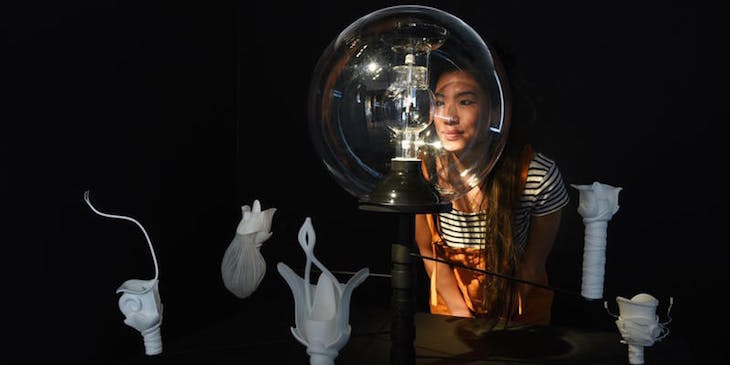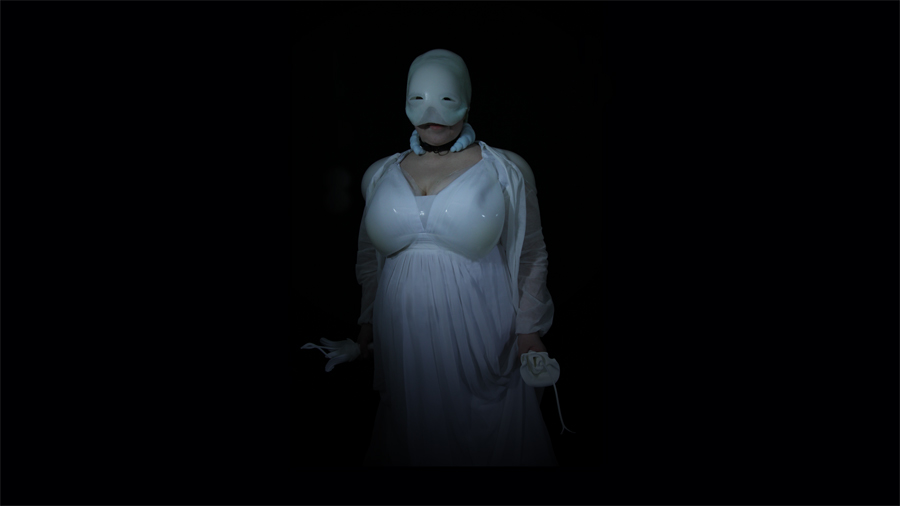Without genre
19 September 2019

BurtonNitta’s ‘New Organs of Creation’ was first presented at The Science Gallery’s 2019 exhibition, ‘Spare Parts.’ in London. The performance aspect of the project received its world premiere on the 8 May 2019 in the Science Gallery Theatre. Read on to understand best practice when stepping outside the boundaries of the traditional rehearsal room to create without limits.
In general terms, the role of a classical singer is that of an interpreter and storyteller. The process that supports this function goes a little bit like this: Getting to know the performative expectations of the genre, period and composer, learning the score, interpreting the score and performing it with or without improvisation or extemporised passages. So, what to do when you are asked to step beyond this process and start at a point of creation that is score-less and genre-less because the function of the singer has shifted?
“Works of art make rules; rules do not make works of art” Claude Debussy
About New Organs of Creation
New Organs of Creation by BurtonNitta, considers a future Britain divided by the ravages of post-Brexit. Blending art, science, technology, music and theatre, they explore the question: Can song save our troubled nation by speaking to us on a cellular level to bridge a future of national divide?
From a music studio to a laboratory and from the visual to the biological, the inter-disciplinary team explored this question by playing with form and function. Principally, seeking to identify the optimal ways to communicate at a cellular level to change physical state to bring about new insight and understanding.
Research evidences that sound between 50-100HZ can direct stem cells into bone cells. Taking inspiration from this, and also the frequencies of other animal’s larynx, like the koala’s mating call and the cat’s purr, decisions were made around the design of a future larynx, song form and the function of a singer:
- A hypothetical human larynx was developed to enable the singer to communicate at a cellular level. The synthetic human larynx was created between BurtonNitta and Prof Lucy Di Silvo (Kings College) using tissue engineering; the scaffold of the larynx 3D printed with Dr Trevor Coward (Kings College). This larynx was designed with the potential to transform state by speaking/singing from 50HZ;
- The structure of a national anthem was subverted to find a vehicle to express a nation’s identity;
- Paradigm shift around the function of a singer; from interpreter to global leader.
The result of this exploration was the creation of a hybrid singer. A national figure enabled to step beyond the future divide.

Meet the hybrid singer
A modern-day Britannia who has transcended myth to step beyond patriotism and patriarchy. This Britannia isn’t an emblem, a good luck charm, or a government and media device. Rather, this Britannia is a global leader with a synthetic larynx and a song that can help unite a divided nation.
Part diplomat, part healer, part singer, Britannia is charged with the purpose to:
- Tune into the national conflict;
- Highlight the problem by giving voice to a nation’s hopes and fears;
- Enable a solution using vibration within a specific hertz range (50HZ – 100HZ) to heal and change state to bring about a bridge to understanding.
As the transformative larynx is hypothetical, for performance purposes, the audio effects of the larynx were re-created through sound engineering: The singer creates a phrase or musical gesture which is electronically interpreted by the sound artist within the required hertz range. Through structured improvisation, singer and sound artist duet, each adding to the other’s sound, until it fuses in a fulcrum-like expansion that immerses the audience in a reimagined national anthem that speaks directly to their bodies at a cellular level and shifts physical state.
Where we started
When we stepped into the studio for the first time, there was no genre, no score and no modality. But we had a question – a reason for stepping into the unknown. To start to answer the question, Matt Rogers (composer), David Sheppard (sound artist), and myself, Louise Ashcroft (mezzo soprano) – explored vibration and we immersed ourselves in the nation’s diverse and divided voice on Brexit.
After the co-creation period was completed, there was a score, but not in the traditional sense, and in terms of genre, it was still rather hard to pin down: cyber punk avant-garde national anthem? Categories don’t serve us here, best to look at what we had: An incredibly detailed and blended sound/visual world divided into three sections. Lasting c.45 minutes, the singer and sound designer share this world via a duet based on a structured improvisation framework dialled into a hertz range with the potential to build a bridge of understanding.
Sharing best practice
In BurtonNitta’s paradigm, the singer is the room, there are no words, and breath is the modality. Looking back to the co-creation and performance process, here are the elements that powerfully directed us towards creating the new world and engaging with our audience:
To create a new world leave the old world rules behind.
When we were exploring vocal form, we looked not at the musical structure, but rather at purpose. So when we began to contemplate the form of a national anthem and how it might heal a divided nation, we focused not on patriotic modalities and melody, but rather on the single purpose: how to unite a nation/community. We asked, what is the common element that unites us all? What changes our state? What divides us?
We quickly realised that words divide because language is entrenched in identity. But breath is universal and a fast state changer. Hence, breath became our modality, our language, our commonality and a point of healing.
Live with your character.
The character of New Organs of Creation is a modern-day Britannia born out of the struggles of needing a spare larynx due to vocal misuse from trying to make it as an opera star. The synthetic larynx has given a new purpose in life; to heal the world through voice. Despite this altruism and high status, Britannia is not the protagonist. Rather, the roles are inverted; Britannia is a facilitator for the audience who in turn is the protagonist.
In this scenario, the audience is the singer’s muse. By tuning into their hopes and fears the singer is able to give voice to the problem and then build a pathway towards a solution through a healing duet with the sound artist.
To prepare for this role, Britannia was created from researching sound healing practitioners, Britannia-like historical figures, and imagining how the singer would act in the world we were creating. I asked myself, what are the actions our modern-day Britannia takes every day to step towards their purpose? What does living mean: from sleeping to eating, from loving to exercise? What does Britannia read and believe in to fuel transformation and leave their old life behind?
Creating at a three-dimensional level meant it was possible to open a door in my mind and immediately step into Britannia’s world. Ultimately, the richness of the back story enabled me to fuel my presence and connection with the audience.
Being present
When co-creating and preparing the role, I asked: ‘What do I need to shift to help me vocally align to the needs of the project?’ Something unvocal came up.
I discovered that the biggest adjustment and preparation I could do for this role was to develop my practice of presence. Two months before the world premiere, I engaged in an additional 30 minutes of mindfulness before my vocal and physical warm up to help support the improvisation and audience connection work I would be doing.
When abstracting to pure sound, be specific.
Having decided early on in the process that words divide, we made the decision that sound would be based on breath. Vocal extended technique became the source of vocalisation. Breath connected to thought created the sound; from long extended notes to speech patterns.
When abstracting characters and scenarios to basic sound, to honour the integrity of the character, the advice of Uta Hagen ‘be specific’ was my red thread. As soon as I become general and just focused on sound, it no longer communicated, it was undirected noise.
The top tip to share, therefore, is connect the why to the sound, bring the character into the room as you dialogue with them. If it’s alive in your mind, the audience will see it and be able to connect on a human level.
Find the point of mastery
When approaching a Mozart aria, a Schubert lied, or a cabaret song, we are always clear on what the point of vocal mastery is that will help the song vocally live in you and step off the page into the audience’s hearts.
Breath provided the point of mastery in this piece. When considering the different ways air can be filtered and directed, I tapped into the purpose of the singer in order to collect the breath sounds that would bring about the optimum hertz needed to heal.
Plosive breath, pitched breath, articulated breath, silent breath, and onset breath offered a myriad of choices to help create the healing landscape. From the wet, intuning landscape of Section 1, through to the dry, healing landscape of Section 3, all this was driven by adventures with breath, a muscular control of the tongue and developing a working relationship with a sensitive microphone.
Section 2 was giving voice to the hopes and fears of the audience. Based on the testimonials of people that lived in the United Kingdom, I abstracted their dialogue into vocal extended technique passages, where their thoughts and attitude were expressed through filtered breath, sighs, twanged hums, tongue articulation, breathy sustained notes, and silence.
To help me achieve this, I tuned into:
- people’s vocal and thought ticks – like when a person keeps repeating the same phrase or word
- the shape of their speech pattern
- a point of physicality
- a repeatable action
- a home note (the note/interval/mode of an individual’s speech pattern)
All these gestures were then abstracted and interpreted to create a vocal language where the singer expresses the voices of the voiceless.
Summary
The artist, writer and poet, Dorothea Tanning (1910 – 2012), dedicated her life to creating without limits, so she could:
“See new worlds, new visions, new realms beyond and behind those of the everyday”
Whether your vocal project is genre-full or genre-less, we can take note from her approach by looking beyond ourselves to find the new in the known and to create without limits.
